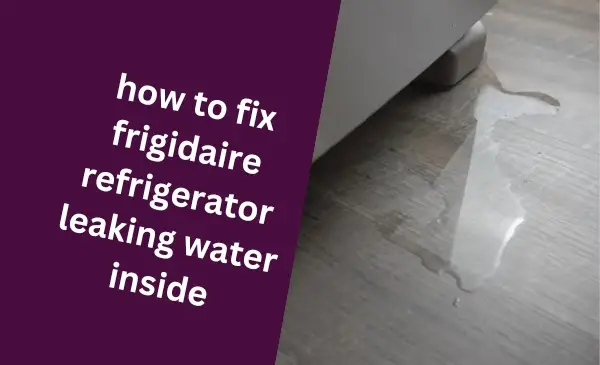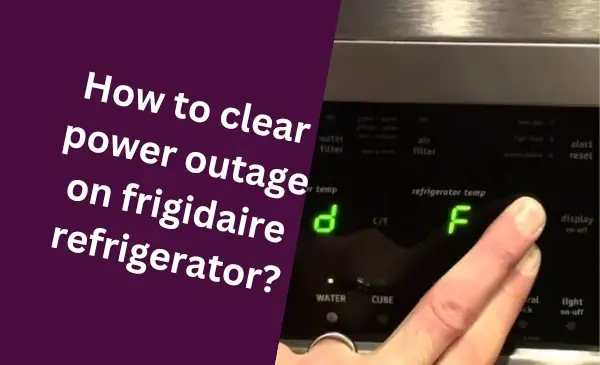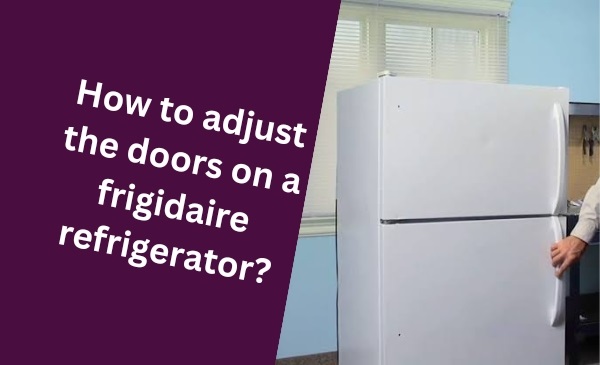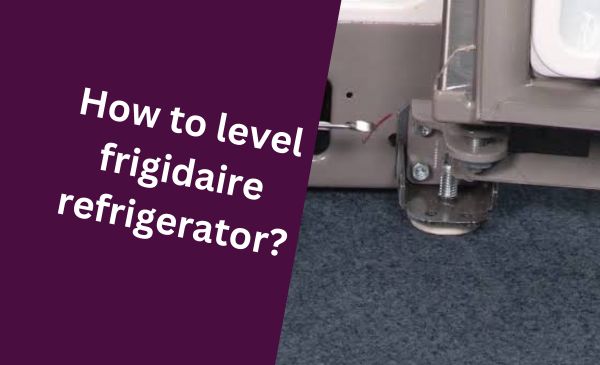A Frigidaire refrigerator is a crucial appliance in any household, keeping your food fresh and safe. However, when it malfunctions and fails to cool properly, it can lead to food spoilage and safety concerns. If your Frigidaire refrigerator is not cooling as it should, don’t panic! This guide will provide you with quick and effective solutions to get your refrigerator back to its optimal cooling performance.
Refrigerators play a vital role in maintaining food quality and preventing spoilage. When a refrigerator malfunctions and stops cooling, it can lead to a cascade of issues, affecting both the safety and freshness of your food. Frigidaire refrigerators, known for their reliability, can occasionally experience cooling problems, leaving users scrambling for solutions.
In this comprehensive guide, we’ll delve into the common causes of Frigidaire refrigerator cooling issues and provide you with step-by-step instructions on how to troubleshoot and resolve these problems quickly and efficiently. Whether it’s a faulty thermostat, a blocked condenser coil, or a malfunctioning defrost timer, we’ll empower you to identify and address the root cause, restoring your refrigerator’s cooling function and ensuring your food remains safe and fresh.
Common Causes Of A Frigidaire Refrigerator Not Cooling
Your Frigidaire refrigerator not cooling properly can be a frustrating problem to deal with. When your refrigerator fails to maintain a cold temperature, it can lead to spoilage of food and drinks. In this section, we will explore the common causes of a Frigidaire refrigerator not cooling and provide solutions to address each issue.
By understanding these common problems, you can troubleshoot and fix your refrigerator to ensure it operates at optimal cooling levels.
Malfunctioning Thermostat
One common cause of a Frigidaire refrigerator not cooling is a malfunctioning thermostat. The thermostat is responsible for regulating the temperature inside the refrigerator. If it is not functioning correctly, it may not signal the cooling system to activate, resulting in inadequate cooling.
To check if the thermostat is the culprit, try turning the temperature dial to the coldest setting and see if there is any change in cooling. If not, it may be necessary to replace the thermostat.
Blocked Or Dirty Condenser Coils
Blocked or dirty condenser coils can also cause your Frigidaire refrigerator to lose its cooling ability. These coils are located at the back or underneath the refrigerator and are responsible for releasing heat from the unit. Over time, the condenser coils can accumulate dust, dirt, and debris, hindering their ability to dissipate heat effectively.
This can result in a decline in cooling performance. To resolve this issue, gently clean the condenser coils using a brush or vacuum cleaner. Ensure the refrigerator is unplugged before attempting any cleaning.
Faulty Evaporator Fan Motor
The evaporator fan motor plays a crucial role in circulating cold air throughout the refrigerator. If this motor is faulty, it can lead to inadequate cooling. You can check if the evaporator fan motor is running by opening the freezer door and listening for the sound of the fan. If there is no sound, the motor may need to be replaced.
Additionally, a worn-out fan motor can cause the freezer compartment to cool more than the refrigerator section. Replacing the fan motor can help restore proper cooling in both compartments.
Inadequate Airflow Due To A Blocked Air Vent
Inadequate airflow due to a blocked air vent can greatly impact the cooling performance of your Frigidaire refrigerator. The air vent allows cold air to flow from the freezer to the refrigerator compartment. If it becomes blocked by food items or other obstructions, the airflow is restricted, resulting in decreased cooling.
To address this issue, ensure the air vent is clear from any obstacles. Reorganize the contents of your refrigerator to allow proper airflow and avoid placing items directly in front of the air vent.
Checking And Troubleshooting The Thermostat
If your Frigidaire refrigerator is not cooling properly, one of the potential culprits could be a malfunctioning thermostat. The thermostat is responsible for regulating the temperature inside the refrigerator, ensuring that it stays at the desired level. To effectively troubleshoot and fix this issue, you can perform a series of checks and tests on the thermostat.
This section will guide you through the process of testing for continuity, adjusting the temperature settings, and replacing a faulty thermostat.
Testing The Thermostat For Continuity
Before proceeding with any troubleshooting, it’s important to determine whether the thermostat has continuity or not. This can be done by following these simple steps:
- Disconnect the refrigerator from the power source to ensure safety.
- Locate the thermostat, which is usually mounted inside the refrigerator near the back wall or behind the control panel.
- Remove the thermostat cover or control panel, depending on the model of your Frigidaire refrigerator.
- Using a multimeter set to the continuity mode, touch the meter’s probes to the terminals on the thermostat.
- If the meter shows continuity, it means the thermostat is working properly. If there is no continuity, it indicates a faulty thermostat that needs to be replaced.
Adjusting The Temperature Settings
If the thermostat has continuity and appears to be functioning correctly, the next step is to check and adjust the temperature settings. This can be done by following these steps:
- Locate the temperature control dial or buttons, usually located inside the refrigerator section.
- Check the current temperature setting and compare it to the recommended temperature range for the refrigerator. This information can usually be found in the user manual or on the manufacturer’s website.
- If the setting is too high or too low, adjust it accordingly by turning the dial or pressing the buttons. Gradually increase or decrease the temperature and wait for a few hours to see if the cooling improves.
- Monitor the refrigerator’s temperature over the next few days to ensure it stays within the recommended range.
Replacing A Faulty Thermostat
If testing the thermostat for continuity reveals a lack of continuity or if adjusting the temperature settings does not resolve the cooling issue, it’s likely that the thermostat is faulty and needs to be replaced. Here’s how you can go about replacing it:
- Refer to the user manual or consult the manufacturer’s website to locate the correct replacement thermostat for your specific Frigidaire refrigerator model.
- Disconnect the refrigerator from the power source.
- Remove the faulty thermostat by disconnecting the wires attached to it.
- Install the new thermostat by connecting the wires according to the labeled terminals.
- Reassemble the thermostat cover or control panel, ensuring it is securely in place.
- Reconnect the refrigerator to the power source and monitor the cooling to confirm if the issue has been resolved.
Cleaning The Condenser Coils
Cleaning the condenser coils of your Frigidaire refrigerator is a crucial step in ensuring that it functions at its best. Over time, dust and debris can accumulate on these coils, causing them to become less efficient in cooling the refrigerator. In this section, we will guide you through the process of cleaning the condenser coils, step by step.
Locating The Condenser Coils
Before you can begin the cleaning process, you need to locate the condenser coils. In most Frigidaire refrigerators, the condenser coils are situated at the back or underneath the unit. To access the coils at the back, you may need to pull the refrigerator away from the wall gently. If the coils are located underneath, you might find a grill or a panel that needs to be removed to expose them. Once you have located the condenser coils, you are ready to move on to the next step.
Removing Dust And Debris
Once the condenser coils are exposed, it’s time to remove the accumulated dust and debris. This build-up can restrict airflow and prevent the coils from effectively cooling the refrigerator. To remove the debris, you can use a vacuum cleaner with a soft brush attachment. Gently run the brush along the coils, loosening and sucking up any dirt or particles.
Make sure to pay extra attention to areas where the dust appears to be more concentrated. Removing as much dust as possible will improve the overall performance of your refrigerator.
Using A Coil Brush For Thorough Cleaning
While using a vacuum cleaner is an effective way to remove loose debris, it may not reach into the tight spaces between the coils. To ensure a thorough cleaning, it is recommended to use a coil brush. The coil brush is designed with bristles specifically tailored to fit in between the coils, allowing for a more effective cleaning process.
Start by inserting the brush gently between the coils and moving it up and down to dislodge any dirt or debris that the vacuum cleaner might have missed. Be careful not to use excessive force, as this could damage the coils. Cleaning the condenser coils of your Frigidaire refrigerator is a simple yet essential maintenance task that can greatly improve its cooling performance.
By locating the coils, removing the dust and debris, and using a coil brush for a thorough cleaning, you can ensure that your refrigerator functions optimally for years to come. Regularly cleaning the condenser coils will not only prolong the life of your refrigerator but also save on energy costs. Make it a part of your maintenance routine, and you’ll reap the benefits of a cool and efficient refrigerator.

Credit: www.bobvila.com
Fixing The Evaporator Fan Motor
When it comes to a Frigidaire refrigerator not cooling, one of the potential culprits could be a faulty evaporator fan motor. The evaporator fan motor is responsible for circulating air throughout the refrigerator, helping to cool the contents inside. If this fan motor is not functioning properly, it can lead to inadequate cooling and potential spoilage of your food.
Identifying The Location Of The Evaporator Fan Motor
Before you can fix the evaporator fan motor, you need to know where to find it. The location of the fan motor may vary depending on the model and type of your Frigidaire refrigerator. In most cases, you can locate the evaporator fan motor by opening the freezer compartment and looking for a small fan housed behind a panel.
It is usually positioned near the evaporator coils. Refer to your Frigidaire refrigerator’s user manual or the manufacturer’s website for specific instructions on finding the evaporator fan motor for your model.
Checking For Obstructions Or Damage
Once you have located the evaporator fan motor, the next step is to check for any obstructions or damage that may be affecting its performance. Start by examining the blades of the fan, ensuring that they are free of any debris or ice buildup. Use a soft cloth to gently clean the blades if necessary.
Additionally, inspect the wiring connected to the fan motor for any signs of wear or damage. If you notice any broken wires or loose connections, they may need to be repaired or replaced.
Replacing A Faulty Fan Motor
If you have determined that the evaporator fan motor is indeed faulty and needs to be replaced, follow these steps:
- Unplug the refrigerator from the power source.
- Remove any shelves or items that may be blocking access to the evaporator fan motor.
- Disconnect the wiring harness attached to the fan motor, carefully removing any clips or connectors.
- Remove the screws or fasteners securing the fan motor in place.
- Gently pull out the old fan motor, taking care not to damage any surrounding components.
- Insert the new fan motor in the same position and secure it with screws or fasteners.
- Reattach the wiring harness, ensuring a secure connection.
- Replace any shelves or items that were removed.
- Plug the refrigerator back into the power source.
Once you have completed these steps, turn on your Frigidaire refrigerator and monitor its cooling performance. The new evaporator fan motor should help restore proper cooling and ensure your food stays fresh for longer.
Ensuring Adequate Airflow
A common issue with Frigidaire refrigerators not cooling properly is inadequate airflow. Proper airflow is essential for maintaining optimal cooling performance. When the airflow is restricted, heat can build up inside the refrigerator, resulting in insufficient cooling. In this section, we will explore three key steps to ensure adequate airflow and get your Frigidaire refrigerator cooling again.
Locating The Air Vents In The Refrigerator
A crucial first step in ensuring proper airflow is to locate the air vents in your Frigidaire refrigerator. These vents are typically situated at the back of the refrigerator compartment or inside the freezer section. Take a moment to familiarize yourself with the location of these vents.
Removing Any Blockages Or Obstructions
Next, it’s important to check for and remove any blockages or obstructions that may be obstructing the airflow. Over time, dust, food particles, or packaging materials can accumulate around the vents, hindering the flow of cool air. Carefully inspect and clean both the interior and the exterior of the vents.
If you notice any visible blockages, it is advisable to use a soft brush or cloth to gently remove them. Avoid using sharp objects or excessive force, as this can damage the delicate components of the refrigerator.
Adjusting The Temperature And Humidity Settings For Better Airflow
In addition to cleaning the vents, adjusting the temperature and humidity settings can greatly improve the airflow inside your Frigidaire refrigerator. High humidity levels can lead to the formation of frost or ice, which can impede the proper circulation of air.
Ensure that the temperature settings are within the recommended range for the refrigerator and freezer compartments, typically between 36 and 38 degrees Fahrenheit for the refrigerator and 0 degrees Fahrenheit for the freezer. Additionally, setting the humidity control to an appropriate level can help prevent excessive condensation and frost accumulation.
| Action | Instructions |
| Locating air vents | Familiarize yourself with the location of the air vents in your Frigidaire refrigerator. |
| Removing blockages | Carefully inspect and clean both the interior and exterior of the vents, removing any visible blockages with a soft brush or cloth. |
| Adjusting temperature and humidity settings | Ensure temperature settings are within the recommended range and set the humidity control to an appropriate level. |
By following these steps, you can ensure adequate airflow in your Frigidaire refrigerator, resolving the cooling issue and restoring its optimal performance. If the problem persists after performing these troubleshooting steps, it may be necessary to consult a professional technician for further assistance.
Bonus Tips For Optimal Refrigerator Performance
While troubleshooting and fixing a Frigidaire refrigerator that’s not cooling is crucial, it’s equally important to know how to maintain optimal performance once the issue is resolved. By following these bonus tips, you can ensure that your refrigerator operates efficiently and keeps your food fresh for longer:
Keeping The Refrigerator Well-ventilated
Adequate ventilation is essential for your Frigidaire refrigerator to function at its best. Make sure to leave enough space around the fridge to allow proper airflow. Avoid placing the refrigerator against the wall or tightly between other appliances. Allow at least two inches of space between the back of the fridge and the wall, as well as a couple of inches of clearance on all sides.
Regularly Defrosting The Freezer
Frost buildup in the freezer can hinder its cooling ability and make your refrigerator work harder to maintain the desired temperature. To prevent this, it’s important to regularly defrost your Frigidaire refrigerator. Check the manufacturer’s instructions to determine the recommended frequency of defrosting. Typically, defrosting every three to four months is sufficient for most models.
Avoiding Overloading The Refrigerator With Items
Overloading your refrigerator can obstruct airflow and cause uneven cooling. To maintain optimal performance, be mindful of the items you store in your fridge. Avoid cramming it full to the brim, as this can lead to poor circulation and potentially affect cooling efficiency. Organize your food items and leave enough space for air to circulate within the refrigerator compartment.
By implementing these bonus tips, you can maximize the performance of your Frigidaire refrigerator and enjoy fresh and properly chilled food for longer periods.
Frequently Asked Questions For How To Fix Frigidaire Refrigerator Not Cooling
How Do I Fix My Frigidaire Refrigerator Not Cooling?
To fix a Frigidaire refrigerator not cooling, first check if the condenser coils are dirty and clean them. Ensure that the temperature control settings are correct. Verify if the evaporator fan motor is working by feeling for airflow in the freezer.
If these solutions don’t work, it might be an issue with the compressor or a refrigerant leak, in which case you should contact a professional technician.
Why Is My Frigidaire Refrigerator Not Cooling But The Freezer Is Fine?
If your Frigidaire refrigerator is not cooling but the freezer is fine, the most common causes could be a faulty evaporator fan motor, a blocked air vent, or a malfunctioning damper control. Check the evaporator fan motor for noise and spinning.
Inspect and remove any obstructions from the air vent and ensure that the damper control is operating correctly. If the issue persists, contact a refrigerator technician for further assistance.
What Are The Signs Of A Bad Compressor On A Frigidaire Refrigerator?
Signs of a bad compressor on a Frigidaire refrigerator include warm temperatures in both the refrigerator and freezer compartments, unusual noises like clicking or buzzing, and the compressor continuously running. Another indicator is if the refrigerator fails to cool even after cleaning the condenser coils and ensuring correct temperature control settings.
In such cases, it is recommended to contact a professional technician to diagnose and replace the faulty compressor.
Conclusion
In a nutshell, troubleshooting your Frigidaire refrigerator not cooling issue doesn’t have to be a daunting task. By following the steps discussed you can identify and fix the problem, ensuring that your refrigerator operates efficiently. Remember to check the thermostat settings, clean the condenser coils, inspect the evaporator fan, and monitor the door seals regularly.
By taking these simple steps, you can enjoy a properly functioning refrigerator and keep your food fresh for longer.
Hello Readers, I am Mechanic Shuvo, a seasoned refrigerator solution expert with over 11 years of hands-on experience in the field. Throughout my career, I've dedicated myself to understanding the ins and outs of refrigeration systems, honing my skills as a refrigerator mechanic. My passion for these appliances led me to create the website "refrigeratorsolutionsguide.com," where I aim to share my wealth of knowledge and expertise with others.
Over the years, I've encountered a wide range of refrigerator issues and have successfully resolved them all. From common problems like temperature fluctuations and strange noises to more complex technical issues, I've seen it all. Through my website, I hope to provide practical solutions, insightful tips, and guidance to help you keep your refrigerators running smoothly.







